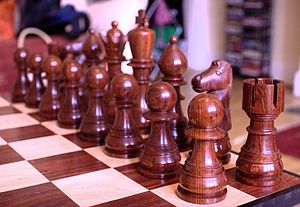Cocobolo

Cocobolois atropicalhardwoodofCentral Americantrees[1]belonging to the genusDalbergia.Only theheartwoodof cocobolo is used; it is usually orange or reddish-brown, often with darker irregular traces weaving through the wood. The heartwood changes color after being cut and can be polished to a lustrous, glassy finish. Being quite dense and sometimes having aspecific gravityof over 1.0, it will sink in water. Thesapwood(not often used) is a creamy yellow with a sharp boundary between it and the heartwood.
Provenance[edit]
Cocobolo is yielded by two to four closely related species of the genusDalbergia,of which the best known isDalbergia retusa,a fair-sized tree, reported to reach 75–80 ft (23–24 m) in height and 3 ft (0.9 m) in diameter;[1]it probably is the species contributing most of the wood in the trade.[citation needed]Because of the high value of the timber, the trees yielding it have been heavily exploited, so they have become rare outside of national parks, reserves, and plantations. Only small amounts of this prized wood reach the world market, and it is expensive.
Oil content[edit]
Cocobolo heartwood contains oil, which lends a strong, unmistakable floral odor even to well seasoned wood and occasionally stains the hands with prolonged exposure. The high natural oil content of the wood makes it difficult to achieve a strong glue joint, as in applyingveneersor guitar fingerboards, and can inhibit the curing of some varnishes, particularly oil-based finishes. Acetone may be used to remove surface oils before gluing.[1]The oil can induce allergic reactions if inhaled or exposed to unprotected skin and eyes. This is due to the presence of allergenic chemicals such asS-4'-hydroxy-4-methoxy dalbergione,R-4-methoxy dalbergione, and otherquinonesandphenols.[2]Adust collection system,coupled with the use ofpersonal protective equipmentsuch as respirators, is highly recommended when machining this wood.
Uses[edit]
Because it stands up well to repeated handling and exposure to water, a common use is forgun gripsandknife handles,and duck calls. It is very hard, fine textured, and dense, yet easily machined. The abundance of natural oils, however, causes the wood to clog abrasives and fine-toothed saw blades, like other hard, densetropical woods.Besides its use on guns and knives, cocobolo is favored for fine inlay work on custom, high-endcue sticks,policebatons,pens, brush backs, bowls, pipes, jewelry boxes, desktops and other expensive specialty items.
Musical instruments[edit]
Due to its density and hardness, even a large block of the cut wood will produce a clear musical tone if struck. Renowned for its "warm, rich palette",[3]cocobolo is used to make musical instruments, such asoboes,flutesandclarinets--especially boutique, custom barrel joints for B-flat clarinets. Other woodwind instruments, such as bagpipes (as well as the chanters of bagpipes' more basic relatives, duck and goose calls), have been successfully made using cocobolo instead of the orchestral and Celtic instruments' customary mpingo, orAfrican blackwood,known in the trade asgrenadilla.Additionally, cocobolo has been used to make fingerboards, as well as entire necks and bodies of guitars and bass guitars, having been employed as a substitute forBrazilian Rosewoodsince that fellow Dalbergia member wasCITESlisted in 1992. Additionally, cocobolo is used to an extent in building drums[citation needed].
Conservation[edit]
Logs, sawn wood, andveneersheets from theGuatemalanpopulations of Cocobolo (Dalbergia retusa), have been listed underCITES Appendix III[clarification needed]since 2008. In 2011,Panamaextended that listing to include all products except seeds and pollen and finished products packaged and ready for retail trade.
As of January 2, 2017, Cocobolo is protected as aCITESAppendix II[4]species, along withBubinga(Guibourtia demeusei, G. pellegriniana, and G. tessmanni), other truerosewoods(Dalbergia spp.) and related species found in the Dalbergia genus, such as Tulipwood, Kingwood, and African Blackwood.
In popular culture[edit]
- Paraguayancocobolo was closely associated withDavid Woodard's iteration of theDreamachine.[5]
- Jim Jarmusch's 2013 filmOnly Lovers Left Alivefeatures a bullet fashioned from cocobolo andbrass.[6]
- One plotline in the television showBetter Call Saulrevolves around the acquisition of a cocobolo desk.[7]
- A cocobolo log plays a prominent role in the "Dead Moon Walking Adventure" episode ofThe Great North.[8]
References[edit]
- ^abc"Cocobolo".Wood.RetrievedMarch 29,2016.
- ^""DALBERGIA RETUSA"".RetrievedMay 11,2019.
- ^"The Howarth XL Oboe"(PDF).Oboe Chicago.Retrieved25 April2017.
- ^"Appendices".CITES.Retrieved2018-09-26.
- ^Allen, M.,"Décor by Timothy Leary",The New York Times,January 20, 2005.Archivedfrom the original on March 12, 2012.
- ^Jarmusch, J.,Only Lovers Left Alivescreenplay,subslikescript,2013.
- ^Bowman, D.,"Better Call Saul,'Bingo' ",The A.V. Club,March 16, 2015.
- ^Scarlata, P.,"'Dead Moon Walking Adventure' Transcript",TV Show Transcripts,April 10, 2022.
